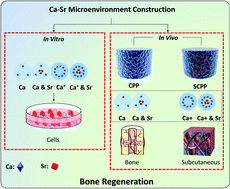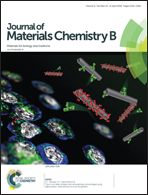Microenvironment construction of strontium–calcium-based biomaterials for bone tissue regeneration: the equilibrium effect of calcium to strontium
Abstract
Strontium-doped calcium phosphate-based biomaterials have gained increased recognition due to their beneficial effects on bone formation. However, the underlying mechanism is still not clear. In this study, we detected the calcification effects of strontium-based materials on osteoblasts in vitro and bone formation in vivo. The results showed that strontium may inhibit bone cell function in osteoblasts under a standard calcium concentration (1.8 mM) by both reducing alkaline phosphatase activity and inhibiting absorption of osteopontin and osteocalcin. In contrast, a high calcium concentration (9 mM) enhances the bone regeneration effect of strontium-based materials. Cultured osteoblasts underwent increased proliferation, calcification and alkaline phosphatase activity upon increasing calcium concentrations. An experimental animal model was utilized to simulate a high calcium concentration microenvironment in bone tissue and low calcium concentration in the subcutaneous part and the in vivo results are similar to the in vitro results. These findings suggest that strontium only promoted an anabolic effect on osteoblasts to enhance osteogenesis in a calcium rich microenvironment. Strontium would inhibit bone regeneration under a low dose of calcium in vivo. Therefore, strontium seems to be a potentially effective therapeutic option for bone regeneration in combination with a high concentration environment of calcium ions. These results would provide an in-depth knowledge of an ion-based bone tissue substitute for bone regeneration.



 Please wait while we load your content...
Please wait while we load your content...